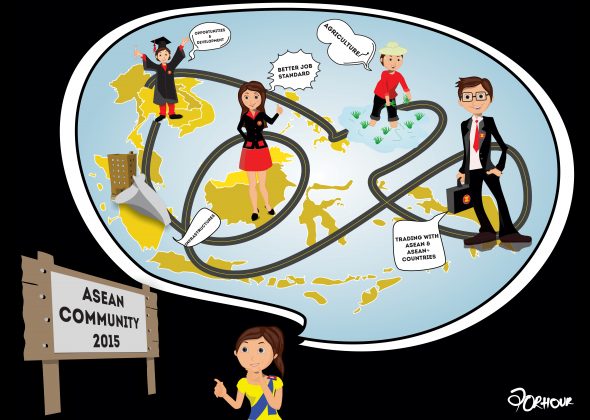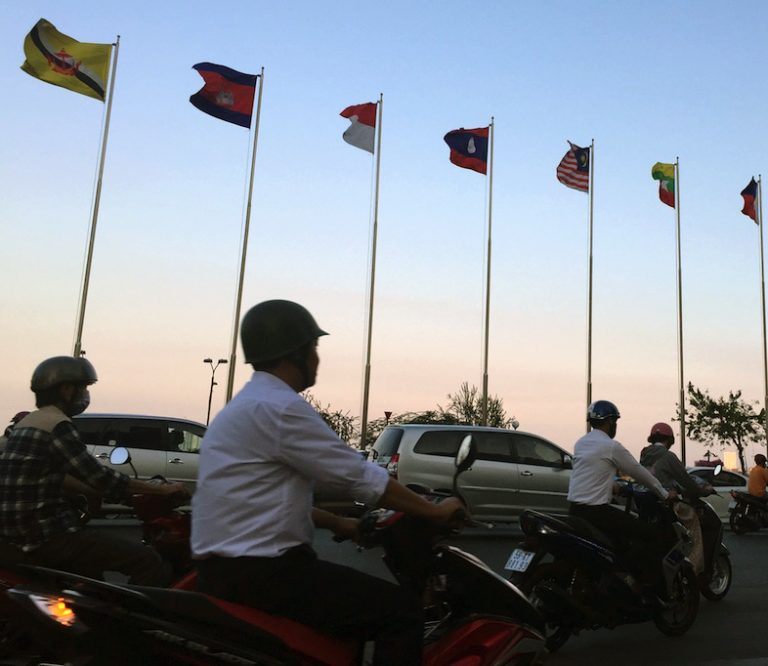|
This article was originally published on Reporting ASEAN in November 2019.
Fifty-two years after its creation and over a decade after its charter came into effect, ASEAN has come quite a way in making its identity more visible. But its identity markers have largely been institutional and confined to bureaucratic circles – having an ASEAN flag for instance – instead of seeping into the public, popular sphere.
These existential identities, which also include having an ASEAN emblem, ASEAN Day (8thof August) and an ASEAN anthem, have in fact gradually become a rallying force in highlighting the very need to broaden the appeal of an ‘ASEAN identity’ from the ground up.
But the process of bringing this further has been far from easy, or straightforward – to think that 2020 has been designated the ‘Year of ASEAN Identity’.
Under the ASEAN Charter, ASEAN member states are supposed to set up ‘ASEAN lanes’ at their international entry points in order to facilitate people-to-people exchange. However, not all members have complied with this.
Thailand was the first to set up an ASEAN lane in 1995, long before the ASEAN Charter’s mandate. Three permanent ASEAN lanes were set up at Suvarnabhumi International Airport last year. Since its ASEAN chairmanship in 2016, Malaysia has been encouraging visitors from ASEAN countries to use their ASEAN lanes.
All these are so different from what the European Union’s member countries have done. All of their international points of entry have two lanes – one for non-EU travelers and another for EU nationals.
It is hard to comprehend why some ASEAN members still resist this practice.

Illustration by Porhour Ly
ASEAN Brands
Citizens of ASEAN countries are also supposed to be able to travel visa-free in all member states, using passports that bear an ASEAN emblem. This may seem a very basic matter. But unfortunately, for the time being, ASEAN has not been able to reach a consensus on adopting a common ASEAN logo on its nationals’ passports, even though the topic has been under discussion for the past decade as a tangible sign of having become the long-awaited ASEAN Community.
The Jakarta-based ASEAN Secretariat is meant to serve as the nerve center for promoting all forms of ASEAN identities. This, however, remains a tall order as each member country remains heavily focused on carrying out the steps they need to take under their integration commitments under ASEAN Vision 2025.
The factors behind why the promotion of a shared identity among 10 diverse ASEAN countries is not an easy, or natural, process lie in ASEAN’s own nature, its history, its expansion.
ASEAN is a community of peoples from diverse political, economic and cultural settings. Since its establishment in 1967, its leaders and peoples have chosen to stick together for their own survival.

From the view of outsiders, ASEAN had no real identity before the ASEAN Charter came into being in 2008. They saw the grouping as a loose gathering of developing nations that had basically decided to tolerate one another’s existence and avoid conflict among themselves.
Article 35 of the ASEAN Charter mandates member states to promote a common identity and a sense of belonging among its peoples to achieve “its shared destiny, goal and values”. Therefore, its drafters set the group’s motto as “One Vision, One Identity, One Community”.
Southeast Asian countries, except for Thailand, had emerged from Western colonization and quickly moved to the nation-building process to reinstitute their indigenous traditions and ways of life. Before long, they also realized that inward-looking and domestic consolidation were no longer sufficient conditions to ensure their countries’ development and progress. In short, they realized they needed to connect to one another.
In 1976, 10 years after ASEAN was founded, its Treaty of Amity and Cooperation in Southeast Asia was enacted. This was the first regional instrument that codified the rules of engagement among ASEAN countries. Among ASEAN members, it is known as the ‘ASEAN Way’.
Its key principles are non-interference and refraining from the threat or use of force, in addition to consensus making and cooperation. The ASEAN Way gained further traction during the Cambodian conflict in the 1970s to the 1990s, due to the association’s distinct ways of engaging the global community at the United Nations to attain peace in Southeast Asia.
Now synonymous with ASEAN’s way of doing things, the ASEAN Way has become ASEAN’s top brand.
After the expansion of its membership in 1995 to 1999, ASEAN has become more diverse with new members that come from different political and economic systems.
Welcome to Disneyland
Today, ASEAN is the Disneyland of world politics. Its member states represent all the political systems in the world, ranging from one-party rule to a totalitarian regime, and from liberal democracies to absolute and constitutional monarchies. ASEAN is also home to the world’s most populous Muslim country, Indonesia, some of today’s largest Buddhist-majority nations such as Thailand, Myanmar, Cambodia and Laos, as well as Asia’s largest Christian nation, the Philippines.
Its diversity and richness have made ASEAN more tolerant and more resilient. This, in turn, helps explain why ASEAN does not follow the EU-style of governance through a supranational organization.
Unlike the EU, ASEAN does not conduct a common defense and foreign policy and approach. But it does maintain common positions on key global issues such as climate change, extremism and maritime security.
However, developing and looking after a sense of belonging in ASEAN is not something that states and governments can nurture by pronouncing policies.
Hopefully, the widespread use of social media among ASEAN citizens provides more popular ways to further strengthen the ASEAN Community and its peoples. Only then can multiple ASEAN identities emerge from the ground up – without resorting to the habitual intervention from the top. (Reporting ASEAN/KC/Edited by Johanna Son)
*
Note to readers: please click the share buttons above or below. Forward this article to your email lists. Crosspost on your blog site, internet forums. etc.
Kavi Chongkittavorn is a senior fellow at the Institute of Strategic and International Studies, Chulalongkorn University in Bangkok, Thailand. This analysis is part of the Reporting ASEAN series.
All images in this article are from Reporting ASEAN unless otherwise stated
Related
|